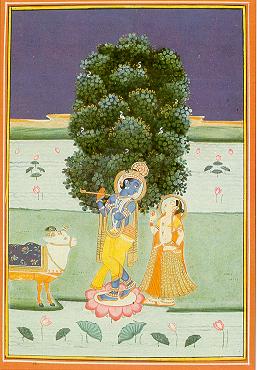|
The
North Indian Classical Music
Recording Project

Krishna is portrayed in
what is probably
a 19th painting from Jaipur, Rajasthan
The
team at DoveSong.com would like to create an online repository
of performances of North Indian Classical Music
Background
The
tradition of classical music in Northern India and Pakistan is an old one that goes back as far, if not farther, than the
tradition of classical music in the west. Based on a melodic
and rhythmic system of ragas and talas, performances of the
music present an unfolding and development of these melodic
and rhythmic ideas.
Every
performance by one of India's great artists is an important
event, and because of the improvised, or on-the-spot
composition of material presented in the performance, it is a one-of-a-kind
representation. For this reason, most all performances by
India's master artists have been recorded. Some of these performances
have been reproduced as commercial recordings, but
most are simply stored and shared among admirers of the
music. The quality of these recordings vary, from high
quality, to poor.
Recording
the music is no longer problematic now that the record label
is no longer involved. Large mixing consoles and stage
monitoring are not needed. Excellent recording these days can
be accomplished with a laptop computer and a pair of $500
microphones. Once the recordings are on the hard drive, they
can be edited, then saved to CDRs, to be later converted into
MP3 format using a simple $29.00 program available at any Comp
USA or free from the Internet
The
chances that these recordings will be made available as
commercial CDs is not that great considering the cost and the
limited listenership. However, some companies have undertaken
projects that have made some of this music available.
DoveSong.com
is proposing that a central database be
set up into these recordings be entered. Once the database is
set up and the web pages have been created to access this
database, those involved in the project would receive a
password for accessing the database (however, the contents
could be viewed by anyone).
The
MP3 Project's Computer
Once
the recordings have been completed, they would be copied to
the server dedicated to the project. Information about the recording, the composer, and the
composition is entered along with the actual MP3 recording.
Once the recording is in the database, the web pages that
refer to the library would automatically updated, as soon as
the directory is modified (when new mp3 files are loaded).
The
database could
be searched by raga, tala, artists, year, etc.
New
web pages would be created to access the Library, which would have its own domain name,
separate from that of DoveSong.com. For example, a
name such as www.NorthIndianClassical.org,
or perhaps something similar.
Thus,
through contributions of a server computer, internet access,
domain registration, enough money to fund the writing of the
software for the new website, and most importantly the
commitment from the artists and those who own the recorded
performances, a great body major recordings could gradually become
available to anyone in the world with computer access and a
sound card.
An
Important Project
The
team at DoveSong.com recognizes that the advances in technology
in just a decade have made projects such as these possible for the first time ever. It is up to us, those who understand
this and realize how easily we can make a difference, to help
in the process of using technology to achieve important goals.
The
Recording project can go much further than what we have just
described. Recordings can be made of great classical music
traditions from all cultures in the same manner as we have
just described. Additionally, directories for storing midi
files can be created for cultures with a tradition of written
music.
|